
This page created 29 March 2014, and last modified: 6 October 2015 (Vegetius reference added)

In the eastern half of the empire, the third-most senior unit of the legiones palatina under the command of the first Master of the Soldiers in the Imperial Presence (i.e. the Magister Militum Praesentalis I) is listed as the Herculiani iuniores (9.19 in Ingo Maier's numbering scheme). Its shield pattern (7#4) as shown in various manuscripts, under the matching label (7.d) Herculiani iuniores, is as below:

The shield pattern features an indigo main ground (purple in B, and faded to maroon in M, W), with a blue rim, and a yellow eagle on a perch (the perch is absent in W): the wings are displayed heraldically, with the tips being bent downwards rather than upwards in M and B. The boss (absent in O) is also yellow. The patterns is one of a set of four very similar shield patterns, belonging to the Ioviani seniores (98/9.21), the Herculiani seniores (98/9.22), the Ioviani iuniores (9.18), and the Herculiani iuniores, as the patterns below taken from the Paris manuscript clearly show:

The two paired seniores units are stationed in the west, under the Magister Peditum in his Italian command, while the two paired iuniores units are stationed in the east, both under the Magister Militum Praesentalis I. Despite their close similarities, nonetheless, there are differences. The pattern of the Herculiani iuniores alone, for example, shows the eagle on a trimmed horizontal perch, and thus seems to be depicting not an eagle as such, but rather the image of a gilded eagle carried as a legionary standard - the standard of the legion itself (there are indications the others are also represents standards, but for different reasons).
Robert Grigg, in his 1979 paper (Portrait-Bearing Codicils in the Illustrations of the Notitia Dignitatum?, The Journal of Roman Studies, Vol. 69. (1979), pp. 107-124) maintained that although the "Iovii and Ioviani, for example would be appropriately represented by some form of eagle" (an eagle being an attribute of Jupiter/Iovius), he rather bizarrely stated that the fact that the Herculiani iuniores was also represented by an eagle, and not by a figure of Hercules, was prima facie evidence its pattern was inauthentic. In his 1983 paper (Inconsistency and Lassitude: The Shield Emblems of the Notitia Dignitatum, The Journal of Roman Studies, Vol. 73. (1983), pp. 132-142) he repeated the claim that a unit named after Hercules should feature either "Hercules or one of his well-known attributes", but provided no basis for this bare assertion. Grigg also interpreted the perch of the Herculiani iuniores as "probably [...] a thunderbolt in its talons", which accords with his presumption that the bird shown is an actual Iovian attribute. It is of course possible the original Notitia did show a thunderbolt serving as a perch here, but as small as the shield patterns are drawn in the Notitia, the patterns as we have them are clearly not showing a thunderbolt, just a plain unadorned perch of some discription.
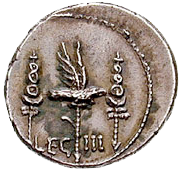
|
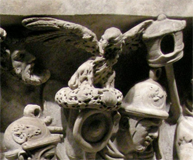
|
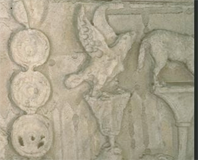
|
|
Aquila of Legio III Cyrenaica, as depicted on a denarius of Marcus Antonius struck in 32 BC. Picture from http://www.cngcoins.com under CCA 3.0 license. |
Aquila of Legio IIII Flavia from the Portonaccio Sarcophagus of ca. 190 AD. Picture from National Museium of Rome under CCA 3.0 license. |
Aquila of Legio I Minerva, from Trajan's column. Picture from National Museium of Rome under CCA 3.0 license. |
Aquilae (legionary eagle standards) seemed to have taken a variety of forms as can be seen from the above representations. Unfortunately no legionary aquila has survived to the present day, although a non-legionary Roman eagle has been recovered from Silchester in Britain, minus its wings.
The original Herculiani legion was a Tetrarchic creation of the last quarter of the 3rd century. Interestingly, the Arch of Galerius (one of the Tetrarchs), shows two shield patterns that apparently belong to the original Ioviani and Herculiani units: one shows an eagle, while the other, as depicted below left, shows Hercules, readily identifiable by his club and lion skin.
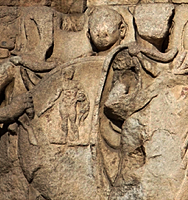
|
Clearly by the time of the Notitia, this exact shield pattern was no longer in use. Grigg made no mention in either of his papers mentioned above of the obvious reason why a unit called Herculiani may not have carried a picture of Hercules on its shields by the time of the Nottia, while a unit called Ioviani may yet have carried an eagle: the clearly pagan image of Hercules would hardly have fitted in well with the now officially Christian nature of the empire, whereas an eagle was a much more neutral image; one that had long been associated with the majesty of Rome itself rather than just its main ancient god. Indeed, this is the exact imagery used in, for example, the Parisian manuscript containing the Notitia itself, which includes the splendid illustration shown to the right. The Bodleian manuscript, O, has the two halves of this picture on separate pages. In both manuscripts, the pictures preface the entire codex, not just the Notitia section. SPQR, "the Roman Senate & People" is another well-known state symbol of Rome.
One possible point at which the Hercules-with-club image could have been superseded was when the original Herculiani unit was split into seniores and iuniores halves. This may have happened in the early 350s: E.A. Mehamadiev has connected the introduction of iuniores-seniores to the problem of replacing the casualties inflicted in the heavy fighting between Magnentius and Constantius II; see here (in Russian). However, it is interesting to note that Magnentius seems to have been even more overtly Christian than Constantius II, to judge from his coins, so my instincts tell me such a date may be too late for such obviously pagan imagery; the unit may have changed its shield pattern even before the death of Constantine I. |
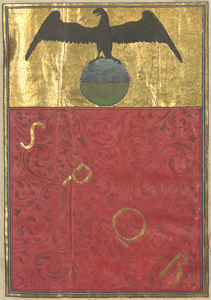
Frontpiece illustration of the Paris manuscript, P. |
Vegetius states (1.17) that the original Herculiani was already in existence when Diocletian became emperor, although this statement is often discounted; it being assumed "the" Herculiani would have been raised during his reign (perhaps as one of legiones II, III, or VI Herculea). However, one should be alive to the possibility that any unit formed by the Romans might have been a more of a rebranding exercise involving one or more former units than enrolling a new body of men. The increase in the number of legions during the Tetrarchy could, for example, have been accomplished by converting auxiliary units into legionary formations as much as by new recruitment.

Return to the Notitia alphabetical unit list page.
Return to my Notitia index page.